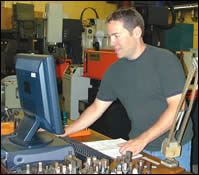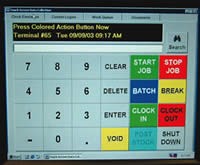The Difference The Software Makes
Looking back, this shop can see clearly what the clues were that it was time for the software to change.
When a machine tool is wrong for the job, the reason why is usually obvious enough. Maybe the machine can’t cut fast enough, or maybe it can’t cut deep enough. Maybe it keeps breaking down. Having the wrong machine tool is an easy problem to diagnose.
Shortcomings of a software product are more difficult to recognize and address. Competing software products tend to offer comparable features, but the products may differ in a variety of subtle ways that affect how well or how easily an important feature works. Short of extensively testing various competing systems—something a shop can’t undertake lightly—there may be no practical way for the shop to know when a different product may better serve its needs.
Magdic Precision Tooling in East McKeesport, Pennsylvania, recently changed both its software and its procedures. The tool and die shop near Pittsburgh installed PCs close to all of its major machine tools to allow part prints to be viewed electronically. The change required MPT to change its shop management software to a system integrated with document viewing software. Shop personnel had struggled to make effective use of the previous shop management system, so company president Joe Magdic had reason to hope a new system might bring other positive changes. But the extent to which the shop might benefit was impossible to predict.
How MPT made its transition to paperless print management is not instructive to the typical shop. MPT had help. It had more help than another shop could expect. More on that in a minute.
What is instructive is the comparison between how well the shop functions today and how much less efficiently it functioned before. The view in retrospect lets this shop see clearly how much improvement it stood to realize not just by making documents more accessible, but also by adopting software better suited to the needs of the shop. Looking back, the shop can see clearly what the symptoms were that indicated it was time for a software change.
“I Didn’t Want A Handout”
MPT is a 19-employee shop whose mix of machine tools places a strong emphasis on EDM. The shop’s specialty is compaction dies. One of the uses for these dies is making carbide cutting tools. Die forms produced by MPT look like drills, end mills and cutting inserts that almost any machine tool user would recognize. Among the shop’s customers is the large cutting tool supplier that also makes its home near Pittsburgh, but the compaction die specialty brings in work from other parts of the country and other continents as well.
Much of the information associated with these jobs is conveyed through hard-copy prints. Detailing the components of a typical die assembly calls for about six prints per job. The use of 2D dimensioned drawings makes sense for this application because many of the components, while they may have challenging tolerances, are relatively simple in form and shape. Machinists working from prints on the shop floor provide the most efficient way to make these parts.
But a difficulty arises from the fact that there are different employees machining different components for a given job simultaneously. That practice used to result in the problem that Joe Magdic long recognized to be a source of lost time: employees searching the shop for prints. Someone working on one component may need a dimension from a print other than the one he has. The shop might have given this employee his own copy of all of the prints, but that would only have created a new problem whenever it came time to track down redundant prints because the job had changed. Thus, the shop came to accept for the time being that employees might lose 20 to 30 minutes apiece each day on visiting other stations in search of information.
Mr. Magdic knew that a paperless system could fix the problem. However, just how much an entirely new system would help the shop—or fail to help the shop—was impossible to predict. That made it a difficult risk to take. Buying the new software and hardware, along with shopping for the right system, installing it, and training all of the employees would sum to a considerable expense.
That’s where the help came in. The shop was working with a local consulting group, Duquesne University’s Industrial Growth Works. The group helps manufacturers in southwestern Pennsylvania to address what the group terms barriers to growth. Through this group, Mr. Magdic was introduced to the Software Engineering Institute, a federally funded organization addressing the software needs of the Department of Defense. Recently the institute was given an additional mission: helping small manufacturers by teaching them how to find and make the best use of commercially available software to improve their own competitiveness. In federal government fashion, the initiative has an acronym; TIDE stands for “Technology Insertion, Demonstration and Evaluation.” But one thing the TIDE program personnel recognized immediately was that they would have to modify the understanding of software implementation that had resulted from their Defense Department work. The program needed learning experiences, and MPT, among other independent manufacturing businesses, seemed to offer a good opportunity. The program offered to find the right software for the shop, buy it with the program’s own funds and oversee the implementation.
At first Mr. Magdic said no. “I didn’t want a handout,” he says.
But from TIDE’s perspective it was no handout—it was an exchange of value. Part of what the program is trying to do is streamline the Software Engineering Institute’s software selection model into something small shops can use. Hands-on experience with MPT would help accomplish this. Program personnel are also working to build an experience base that will let them develop and improve instructional courses related to software implementation. And perhaps most importantly, the program wants to realize case studies of successful implementations that, when publicized (as in the case of this article), will help other shops to more accurately gage the potential benefits of improving their own software technology.
MPT Today
The specific shop management software that gave MPT its document sharing capabilities is the E2 Shop System from Shoptech Software, based in Glastonbury, Connecticut. PCs running this software are now distributed throughout the shop floor. Hard-copy prints coming into the shop are scanned in the office, so the paper no longer has to circulate. The software makes it easy to associate these scanned images with the correct job, and it provides an interface to document viewing software. Thus an employee on the shop floor can now locate and look at the print he needs instantaneously.
The shop realized other benefits as well. The TIDE program’s study of the shop concluded that simplicity was an important consideration. MPT’s previous software was a more complex product, and the complexity created impediments to its ease of use. Employees pressed for time would fail to log into the system or fail to enter data. In fact, this was an important clue that the shop was in need of a software change. Instead of using the system out of habit, employees were in the habit of finding ways to avoid it.
Now, Mr. Magdic says, “They use it all the time.”
They don’t just call up drawings. They also check the estimated time for a job, the progress of the various components of a job, and how well the job is doing at meeting its estimate. Employees are better informed because they have better access to information. They also provide better information, because the system lets them enter basic data with little difficulty. An important result is that Mr. Magdic’s estimates are now much more accurate. That means the time spent searching for prints is not the only potentially costly source of uncertainty the system has brought under control.
So is all of the added efficiency enough to justify the system, if the shop had bought it on its own? That’s the important question. It’s also a question impossible to answer conclusively right now because MPT—like almost any other U.S. tool and die maker—has seen business drop off in recent years. There is no way to truly measure a workflow improvement without a stronger flow of work. However, Mr. Magdic says the shop’s average dollars shipped per labor hour has clearly improved. Business stands to pick up once business picks up for cutting tool makers, plus the shop is courting some alternate markets for the compaction die specialty. If the same level of improvement continues as the shop gets busier, then the new system will indeed give the shop sufficient added capacity to make the cost a good investment.
Plus there are benefits whose value is difficult to quantify. Mr. Magdic says he finds the shop making increasing use of a capability he might never have thought to specify. Thanks to a “Web View” feature, the shop can let customers use a secure Internet connection to call up their own job status information. Mr. Magdic has already equipped three customers to track their jobs this way. These are the three customers who used to have the most frequent need to phone the shop in search of this news.
In the past, when information in the system was less complete, Mr. Magdic would not have wanted customers to have such an unobstructed view. But now he doesn’t have reservations. As a result of a more reliable process, he can now offer a service to customers that lets them save time on obtaining valuable information while his shop saves time on looking it up for them.
This step forward points to one more clue that the shop had been ready to make a change: It wasn’t growing into the previous software. The former system was rich in features, but for the most part they were features MPT was not likely to use. By comparison, software that is a better fit encourages the shop to use it regularly, and using the software regularly lets the shop find ways to use it better
Read Next
3 Mistakes That Cause CNC Programs to Fail
Despite enhancements to manufacturing technology, there are still issues today that can cause programs to fail. These failures can cause lost time, scrapped parts, damaged machines and even injured operators.
Read MoreThe Cut Scene: The Finer Details of Large-Format Machining
Small details and features can have an outsized impact on large parts, such as Barbco’s collapsible utility drill head.
Read More
.jpg;width=70;height=70;mode=crop)









.png;maxWidth=300;quality=90)
















